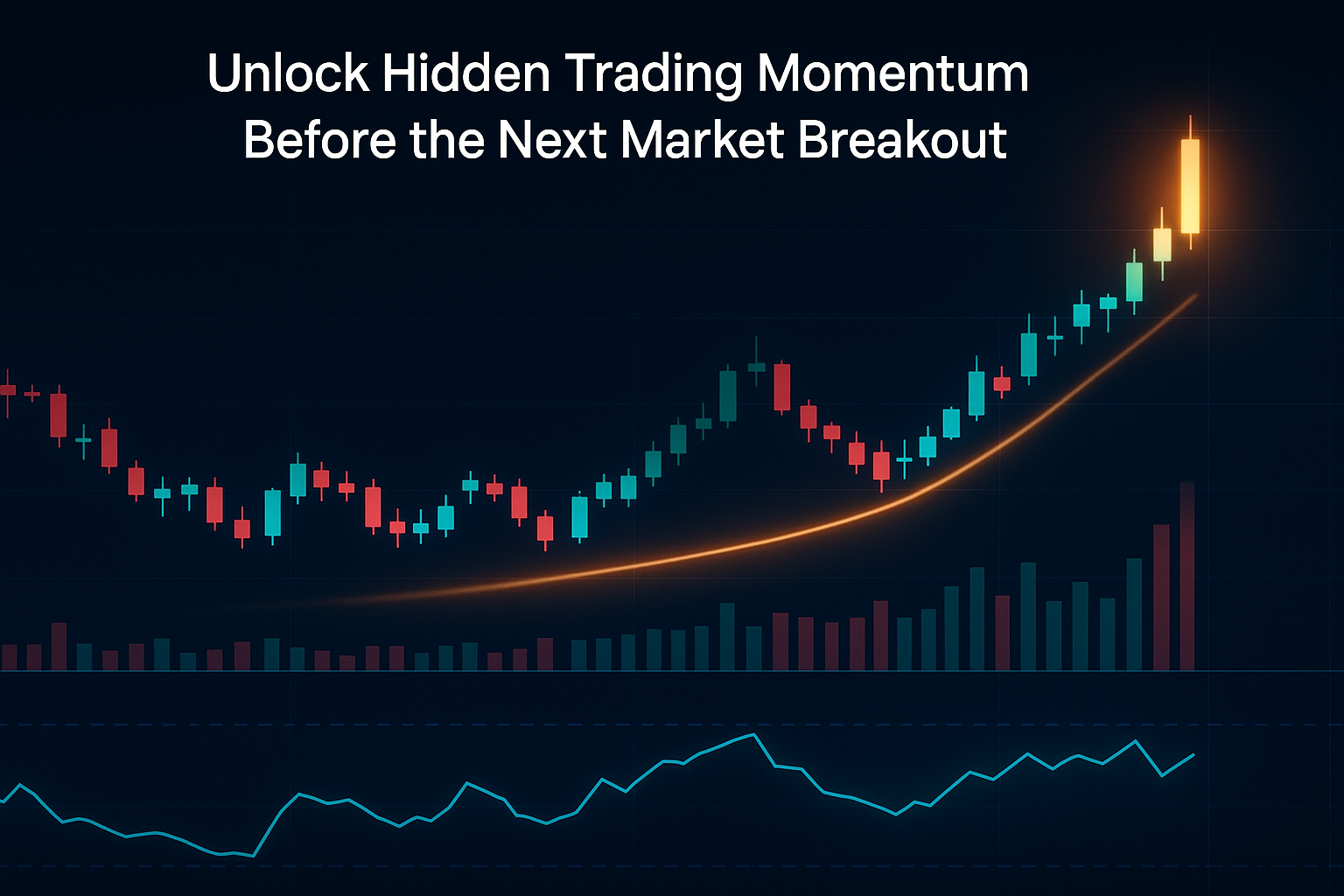Key Takeaways
- Momentum shifts often precede breakouts.
- Volume, RSI, and price structure must align for confirmation.
- Not all volume spikes mean strength — context matters.
- Hidden divergence can hint at early market energy.
- Combine multiple clues, not just one indicator.
Intro: The Invisible Force Behind Every Breakout
Every breakout starts long before the chart explodes. Momentum — the speed and conviction behind price movement — builds quietly beneath the surface.
For traders, catching that early shift in momentum means spotting potential breakouts before the crowd reacts. However, this isn’t about prediction. Rather, it’s about reading the market’s language through clues in volume, RSI, and price structure.
In this guide, you’ll learn how to uncover hidden trading momentum — step by step — before the next big move happens.
The Basics (Beginner): What Is Trading Momentum?
Defining Momentum — Simply
Momentum measures how fast and strong a price is moving. Think of it like a runner’s stride — not just direction, but also the power behind each move.
When momentum is strong, prices move quickly and confidently. Conversely, when it weakens, the market hesitates, often before reversing or consolidating.
Why It Matters
Momentum tends to change before price does. Therefore, recognizing these shifts gives traders an edge.
If you can spot early momentum changes, you can prepare for potential breakouts or reversals in advance.
In other words, momentum is the heartbeat of price action — and the earliest sign of change.
The Why & How (Intermediate): Reading Early Momentum Clues
Momentum isn’t a single indicator; it’s a combination of subtle signals that build up over time.
Here’s how to read those signs clearly.
1. Volume — The Market’s Heartbeat
Volume shows how many traders are active during a move. A breakout on low volume? Often a fake.
A gradual rise in volume before the move? That usually means quiet accumulation.
Moreover, rising volume during consolidation often signals smart money entering before a breakout. So instead of reacting to the move itself, pay attention to how activity builds beforehand.
2. RSI — The Early Pulse Shift
The Relative Strength Index (RSI) measures how “overbought” or “oversold” a market is. Yet, it’s more powerful as a momentum gauge than as a simple buy/sell tool.
For instance:
- When price makes higher highs but RSI makes lower highs → bearish divergence (momentum weakening).
- When price makes lower lows but RSI makes higher lows → bullish divergence (momentum strengthening).
Thus, even before price changes direction, RSI may quietly reveal an early pulse shift.
3. Price Structure — The Footprint of Momentum
Even without indicators, price action itself speaks volumes.
Look for these clues:
- Strong candles with follow-through → confidence.
- Short candles with long wicks → hesitation.
- Tight consolidations near resistance → pressure building.
In summary, when strong price structure aligns with rising volume and improving RSI, it’s a clear momentum alignment that can precede breakouts.
The Deeper Read (Advanced): Spotting Hidden Momentum Before the Crowd
Momentum doesn’t shout; it whispers. Therefore, to truly “unlock” it, you must interpret the subtle alignment of price, volume, and indicators.
1. Momentum Divergence and Market Psychology
When traders chase late moves, momentum fades. As a result, indicators like RSI or MACD show divergences — signs that buying or selling energy is weakening.
Recognizing these divergences early helps you spot when smart money begins to reposition, often right before the rest of the market catches on.
2. Volume Dry-Ups and Expansion
Before a breakout, volume often contracts, then expands sharply when the market finally commits.
This “volatility compression” is where professional traders prepare.
Consequently, patient observers can recognize quiet accumulation phases before explosive price action begins.
3. Multi-Timeframe Confirmation
Momentum builds across different timeframes.
- On the daily chart, look for improving RSI or MACD.
- On the 4-hour chart, watch for price compression.
- On the hourly chart, confirm with a rise in volume.
When these timeframes align, you achieve momentum confluence — a strong signal that energy is accumulating for a breakout.
Example Walkthrough: Spotting Momentum Before a Breakout
Imagine a stock consolidating between $95–$100 for several weeks.
- Volume: Gradually increases each time price nears $100.
- RSI: Builds higher lows even though price remains flat — a bullish divergence.
- Price Action: Candles show longer wicks above $100, indicating growing pressure.
Eventually, volume spikes, RSI crosses 60, and price closes firmly above $100.
Therefore, the breakout didn’t appear suddenly — momentum was signaling it long before.
Common Mistakes When Reading Momentum
Even with the right tools, traders often misinterpret momentum.
Here are the most frequent pitfalls — and how to avoid them.
- Chasing breakouts after they happen.
➜ The goal is to anticipate, not react. - Relying on one indicator.
➜ Momentum should be confirmed by multiple signals. - Ignoring low volume.
➜ Sometimes, quiet volume reflects accumulation, not weakness. - Assuming every divergence means reversal.
➜ Divergences show potential, not certainty — always confirm with price structure.
Mini-Checklist: Spot Hidden Momentum Early
| Step | What to Watch | Why It Matters |
|---|---|---|
| 1 | Rising volume during consolidation | Quiet interest building beneath surface |
| 2 | RSI divergence (higher lows) | Hidden strength forming |
| 3 | Tight trading range | Energy compression phase |
| 4 | Candle closes above key levels | Momentum confirmation |
| 5 | Multi-timeframe alignment | Higher breakout probability |
Conclusion: Learn to Feel the Market’s Pulse
Momentum isn’t magic — it’s simply the energy of participants visible in charts. Once you learn to feel that rhythm, you’ll recognize when the market’s energy is shifting, even before price confirms it.
Instead of guessing where the market will go, learn to read how it’s moving. By combining volume, RSI, and price structure, you’ll uncover the subtle signals that lead to stronger, more confident setups.
Internal Links
- How to Read Volume Like a Pro
- Mastering RSI Divergences
- Understanding Market Breakouts
- ChartsWyn About Page
External Sources
- Investopedia – Momentum Indicators Explained | https://www.investopedia.com
- StockCharts School – RSI and Volume Basics | https://school.stockcharts.com
- Investopedia– Market Momentum Studies | https://www.investopedia.com
FAQ
Q1: What’s the difference between momentum and trend?
Trend is direction, whereas momentum is the speed and strength of that direction.
Q2: Can momentum exist without a breakout?
Yes. Momentum can build within tight ranges before a breakout occurs.
Q3: Which indicator is better for momentum — RSI or MACD?
Both have value. RSI reacts faster, while MACD smooths the data and confirms sustained shifts.
Q4: Does volume always confirm momentum?
Not always, yet sustained increases in volume often validate the strength of a move.
Disclaimer
ChartsWyn provides educational content only; this is not financial advice. Always do your own research and consult a licensed financial advisor before making any trading decisions.



